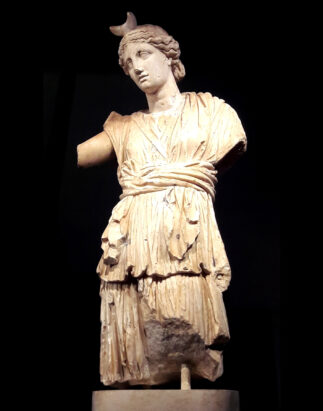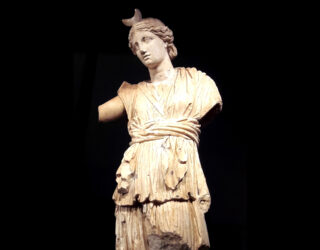Rome-Sabbioneta: the image of the city
Vespasiano Gonzaga dedicated his life to re-founding the town of Sabbioneta under the banner of classical antiquity, both in architecture and decoration. The Prince's architecture was covered externally with marble and internally with Greco-Roman or modern works such as in the Gallery of Antiquities. The exceptional nature of this collection, apart from the quality of the pieces, lies in the concrete survival in pristine condition after the death of Vespasiano Gonzaga and the subsequent events in Sabbioneta. At the end of the 18th century, the artists of the Accademia delle Belle Arti of Mantua who travelled the territory in search of marbles in order to set up a museum found a complete collection in Sabbioneta, unlike what they could find in the other Gonzaga residences which where completely stripped of furnishings. Probably the whitewash lime that covered them to immunise the rooms from the plague allowed them to be mistaken for plaster casts of no great value. And thanks to this 'mistake', the collection of Vespasiano Gonzaga has remained practically intact.
Rome-Sabbioneta: The Prince and the Ancient
In the palaces of Sabbioneta, there were numerous portrait busts inserted into the architectural structure, mostly as a complement to the symbolic route. Many of the busts in the collection of Vespasiano Gonzaga come from the Hall of the Emperors in the Ducal Palace where, in the highest part of the walls, antique sculptures alternated with copies, executed by Bernardino Campi in 1584, of canvases with portraits of the Twelve Caesars painted by Titian shortly before 1540 for Federico II Gonzaga. In many of these portraits only the head is original, while the bust is often not relevant or even reconstructed in the Renaissance period.
The ancient world was symbolically significant for Vespasiano Gonzaga: the constant reference to Rome and its rulers not only had a cultural, aesthetic and representational value, but also political, in which Roman imperial power was for the prince a model of government to which he aspired to.
Antique-False antique
The art market between the 15th and 16th century was characterised by the presence of fake antiques, which were sold as such, i.e. as declared imitations. Various artists ventured into this field of production, often reaching exceptional levels of quality. Hence that the fake was purchased to complete iconographic series (as in the case of effigies of Roman emperors) or to be compared with antique pieces. And in the main centres of antique trade, some artists, such as Tommaso and Giovan Battista della Porta or Antonio Lombardo, specialised in this production, which had a vast market and guaranteed therefore a secure economic income.
The remains of a collection: memories from the land
The Gonzaga family of Mantua was an important collector of antiquities and, in the late 15th and early 17th century, put together an extraordinary antiquarian collection. The original nucleus consisted of Isabella d'Este's antique marbles, but the collection was later enlarged by obtaining locations not only inside the Ducal Palace, but also in other Gonzaga buildings, such as Palazzo Te or Villa Favorita, near Porto Mantovano.
With the sale of the Gonzaga collections to Charles I of England in 1627, the antiquarian collection was first dispersed and then destroyed in the fire at Whitehall Palace in 1698. The Gonzagas attempted to partially rebuild a collection of antiquities with Charles II Gonzaga-Nevers, but this too was lost, as it was transferred to Venice under the last duke Ferdinand Carlo Gonzaga-Nevers and then sold at an auction after his death.
Also notable were the antiquarian collections of the cadet branches, such as that of Vespasiano Gonzaga in Sabbioneta and Rivarolo Mantovano as well as of Cesare Gonzaga in Guastalla. So when at the end of the 18th century the envoys of the Austrian government were looking for materials to build up the collection destined for the palace of the Mantuan Academy of Letters and Arts, they found numerous ancient marbles in the Gonzaga residences in the area and transferred them to Mantua, with the aim of providing the students of the Academy with formal models to imitate, according to neoclassical taste. The collection, initially housed in the upper corridor of the Palazzo degli Studi (today the Biblioteca Teresiana), passed into the hands of the Municipality at the beginning of the 20th century, before being transferred to the Palazzo Ducale in 1915 which today is partly exhibited in this museum.


